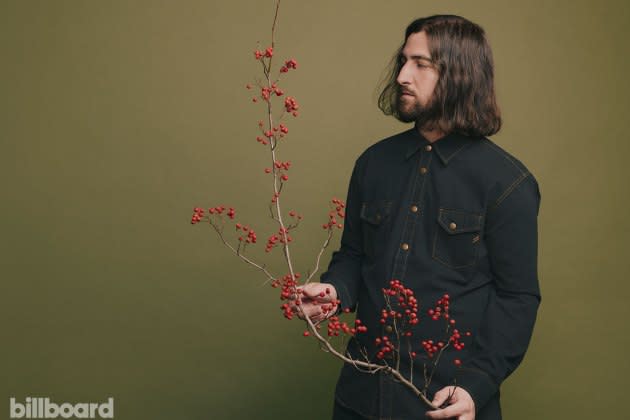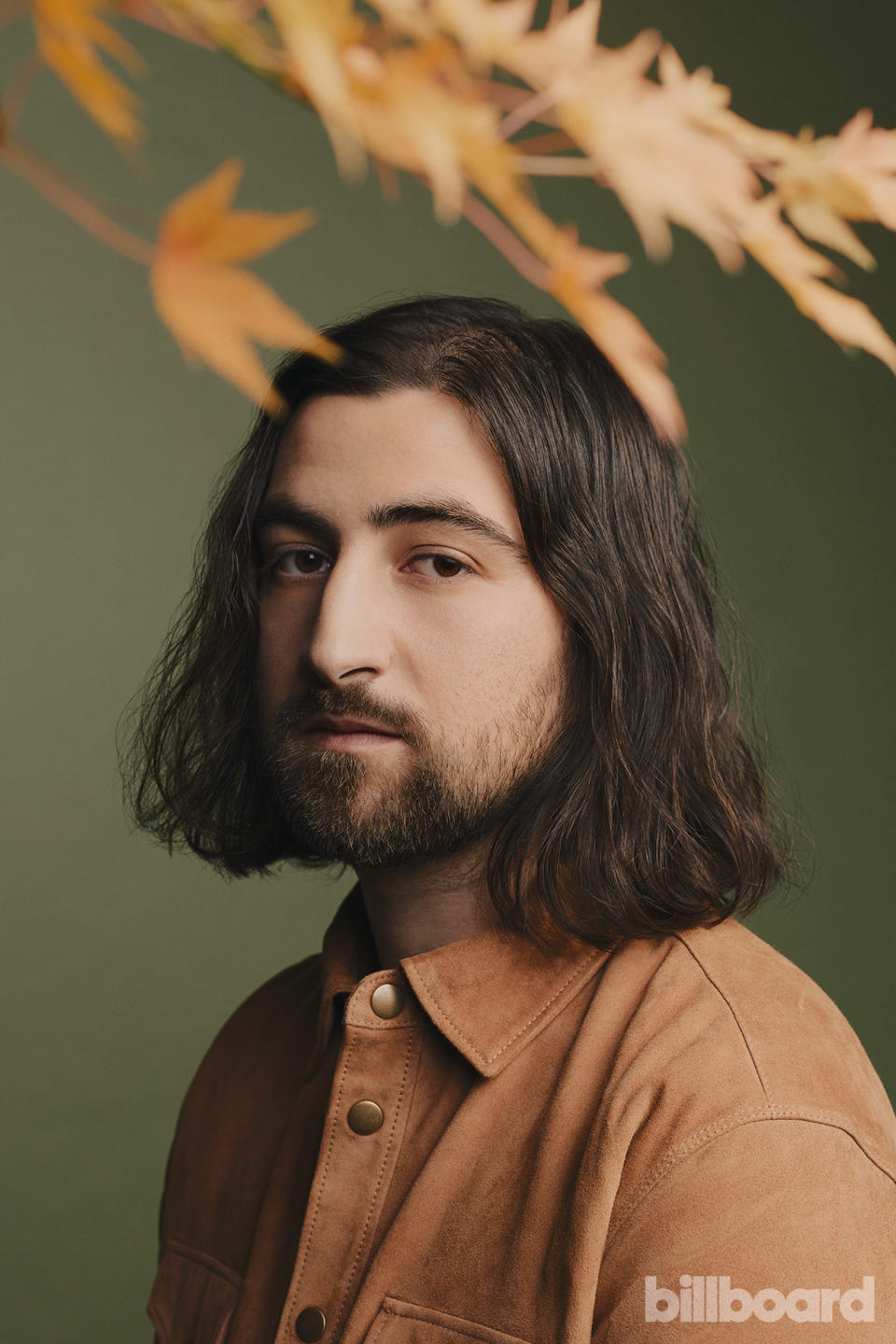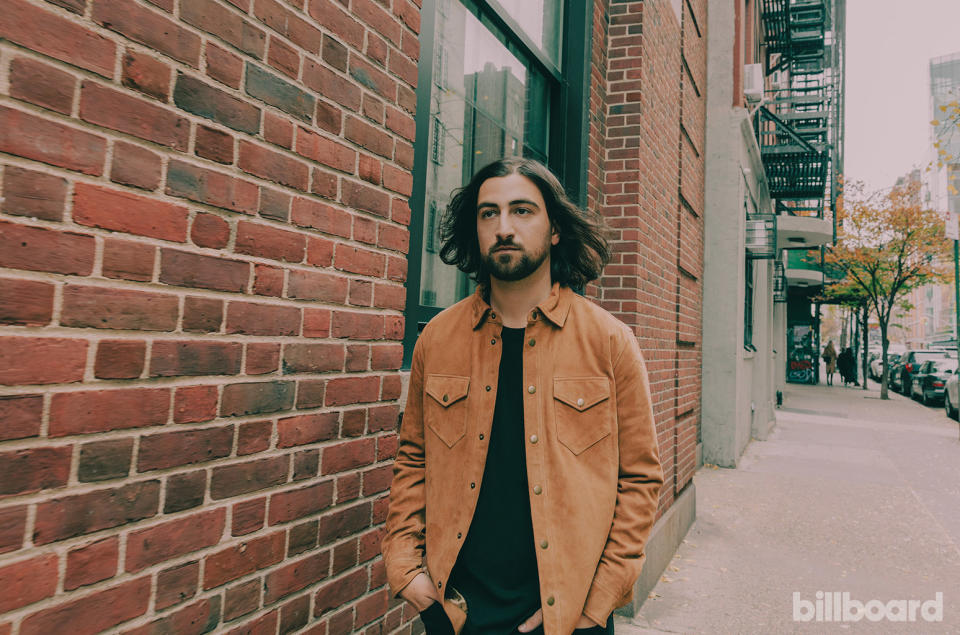How Noah Kahan Turned ‘Stick Season’ Into The Gift That Keeps On Giving

On the Friday before his Saturday Night Live debut, Noah Kahan is still nursing the wounds from an L he took at 30 Rock earlier in the week.
Kahan, the show’s next musical guest, was filming SNL’s obligatory midweek ads alongside cast member Sarah Sherman and host Emma Stone. “I always thought that I could be, like, a funny actor,” says the rising singer-songwriter — who is, indeed, pretty funny on social media. “Did not go down like that.” While Sherman and Stone easily bantered, the usually witty and loquacious Kahan stood stone-still, giving wooden readings of his couple of short lines.
More from Billboard
How Did Noah Kahan Get Back to the Billboard 200’s Top 5 After 15 Months of ‘Stick Season’?
Taylor Swift Wins Artist of the Year at 2024 iHeartRadio Music Awards
Justin Timberlake Kicks Off 2024 iHeartRadio Music Awards With 'Selfish' & 'No Angels' Performance
“I was definitely super-nervous and just kind of like, ‘Oh, my God,’ ” recalls Kahan, 27, still in slight disbelief at his own frozenness. “I feel like I’m usually able to navigate through [moments like that] and make it look OK. But that one, I was like, ‘Man, I just got dominated by Emma Stone and Sarah Sherman.’ ”
It’s a minor loss worth noting — simply because Kahan has had so few over the last year-and-a-half. After an occasionally frustrating first seven years on a major label — he signed to Mercury Records/Republic Records in 2015, recording two albums in more of a folk-pop, James Bay-esque mold — Kahan finally struck pay dirt with 2022’s Stick Season, following both a sonic pivot to alt-folk and a thematic shift to more personal, geographically specific writing based on his experiences growing up in northern New England. The rousing title track went viral on TikTok that summer, and the album debuted at No. 14 on the Billboard 200 in October, Kahan’s first time making the chart.
But 2022 was just the warmup for the cold-weather singer-songwriter, whose sepia-toned ballads and stinging-throat stompers — as well as his breakout hit, named for the time of year in the Northeast when the trees go barren — have made him something of an unofficial ambassador for late autumn. Kahan’s crossover became undeniable in June with the release of his Stick Season deluxe edition, subtitled We’ll All Be Here Forever.
The reissue shot the album to No. 3 on the Billboard 200, largely on the strength of seven new tracks — one of which, the barnstorming, back-of-a-cop-car lament “Dial Drunk,” became his first Billboard Hot 100 hit, after an extensive tease on TikTok. That song went top 40 following the release of its remix featuring fellow Mercury/Republic star Post Malone — which also kick-started a run of new Stick Season remixes, with guests like Kacey Musgraves, Hozier and Gracie Abrams, who boosted their respective tracks onto the Hot 100 for the first time.

As Kahan talks to Billboard in December, he’s also ending 2023 with a number of notable firsts: his first Grammy Award nomination (for best new artist at the Feb. 4 ceremony), the announcement of his first major festival headlining gig (Atlanta’s Shaky Knees this May) and, of course, that SNL debut — which he had originally manifested in a 2021 tweet (“I wanna perform on SNL I don’t even care if it’s a off-brand version called Sunday Night Live”).
And in the end — even if his underwhelming teaser performance didn’t lead to any acting opportunities on his episode — his ripping performances of “Dial Drunk” and “Stick Season” still made for an overall win. Now, with winter on the horizon as we speak, the self-aware Kahan jokingly wonders if his appropriately dominant late-year run may be coming to its seasonal close.
“My time is ending, and we’re going into Bon Iver era now,” he says with a laugh. “He gets the baton.”
Much like the trees’ gradual-then-sudden shedding of their autumn leaves, Stick Season’s takeover may seem — to anyone who wasn’t paying attention — like it came out of nowhere.
But Kahan had been growing his audience steadily, albeit slowly, for nearly a decade. It helped that he had the continued faith of Mercury/Republic, which longtime co-manager Drew Simmons says believed in Kahan’s talent from the first moment he auditioned for the label.
“He just played a couple of songs acoustic for them in their lounge space — and I remember [Republic founder and CEO] Monte Lipman popped in for a minute and was basically like, ‘Sign this kid tomorrow,’ ” Simmons recalls. “He said to Noah, ‘You have no idea how good you are.’ ”
Kahan’s first two albums, 2019’s Busyhead and 2021’s I Was / I Am, showed his talent and promise — particularly his ability to build worlds within a song and his ease with writing and performing shout-along choruses — but their brand of folk-pop aimed perhaps a little too squarely for a top 40 crossover bull’s-eye and suffered for their studiousness. But though both sets’ commercial performance was underwhelming, they allowed Kahan to develop his chops as a road warrior, gigging constantly around the country at midsize venues and developing a devoted following. “Noah’s story is one of proper artist development,” Simmons says. “He’s eight, nine years into his career, but those were really important years for his personal growth, his songwriting growth, his ability to own a live stage.”

But it was Kahan’s Cape Elizabeth EP, released between his first two albums in 2020 at the early height of the COVID-19 pandemic, that offered a blueprint for his later Stick Season success. He pulled back on the busy top 40 production and penned four of the EP’s five intimate tracks without co-writes — and while Cape Elizabeth made minimal mainstream impact, fans’ immediate connection to it showed that Kahan was on to something.
“The path he is on now started during the pandemic while he was home in Vermont and we were all trying to figure out what to do,” says Ben Adelson, executive vp/GM at Mercury. “He had written a lot of great folk songs that he wanted to self-record at home and that became Cape Elizabeth. We fully supported it, and that really helped set the stage for what has come.”
It also helped that around the same time, the mainstream winds were starting to blow back in Kahan’s direction. TikTok’s rise to prominence had provided the world a new, effective communal space for sharing music. And as the global pandemic forced everyone indoors (and inward), Kahan’s brand of introspective, reflective songwriting suddenly found an audience in listeners yearning for simpler times.
That shift could be seen in the slow-building success of organic-sounding, Americana-leaning country singer-songwriters like Tyler Childers and Zach Bryan, both of whom grew star-level followings in the last few years. And of course, no one forecast (or accelerated) the changing tides more than Taylor Swift, whose pair of rootsy 2020 surprise releases (folklore and evermore) put up equivalent numbers to her more pop-oriented releases and effectively raised the commercial ceiling for main-character alt-folk, a more Gen Z-friendly revival of the folk-pop boom of the early 2010s.
“The biggest artist in the world is writing very grounded folk music that tells stories,” recalls Kahan of Swift’s pivot. “And it allowed a huge new audience to find interest in that and to tap into that world. You know, some of these kids might not have been listening to music when Mumford & Sons, when Lumineers [were first around]. Taylor doing that brought that new generation to folk and folk-pop. And I definitely think that helped bring visibility, and some sort of significance, to what I was doing.”
Nearly a decade since the commercial heyday of those strum-and-stomp hit-makers, they remained core influences on Kahan — “I never stopped f–king listening to Mumford & Sons,” he says — so when he decided to head in a new creative direction, alt-folk was a natural home for him. But while most of those groups tended to go lyrically broad with their arena-aimed anthems, Kahan narrowed his writing focus to his own experiences: growing up in Strafford, Vt., and Hanover, N.H., and the struggles with anxiety and depression he’s still navigating today.
“I like to think that storytelling is something that can always bring success, if you tell it in the right way and if you tell it with the right intention,” he says. “And so my intention behind this project actually was really pure — just to talk about New England and to talk about my childhood and my family. I wanted to examine those things, and I wanted to think about my hometown and think about my parents and think about my journey with mental illness — and I have a hard time doing that without writing songs.”
Unlike the previous generation of alt-folkies, Kahan is also, well, funny. His brand of humor is unmistakably influenced by his Jewish heritage on his father’s side — he refers to himself as “Jewish Capaldi” at live shows and says “sometimes I just feel like Larry David walking around” — and makes for a marked contrast from his avowedly straight-faced, chest-pounding antecedents, many of whom sang implicitly or explicitly about Christian themes.
“Growing up half Jewish and having this face on me… it has kind of been a big part of my identity,” he says, laughing. “I’m not going into a song, ‘Let’s get this one extra Jew-y.’ But I think it plays into the cultural aspect of [my music] — into the humor. And down to my diet. Like, I got the acid reflux stomach, just like my dad.”

Religion aside, Kahan’s mannerisms — the mile-a-minute speaking, the gently anxious energy, the self-deprecating and filter-free humor — should be familiar to anyone burdened with both an overachiever’s self-confidence and a late-bloomer’s insecurity. Ultimately, the biggest factor in Kahan’s leap to stardom might be the generation of terminally online, oversharing introverts that recognizes itself in his personality (both onstage and on social media) as well as in his lyrics. And that manifests at his shows, which are increasing in size — beyond festival headlining, Kahan will embark on his first amphitheater and arena tour this summer — without losing their immediacy and intensity, as crowds in the thousands now shout Kahan’s incredibly personal words back at him.
“No one else can tell my own story,” Kahan says. “And if people want to hear your story, then you’re in a really awesome position, because you hold the key to your own memories and people are interested in what those memories mean to you — and find connections to their own memories, to their own lives.”
While Kahan may have joked in December about passing the folk torch to Justin Vernon — the genre’s esteemed dead-of-winter representative — Stick Season actually has no end in sight. Kahan’s touring in support of the album will take him through Europe and Canada the next few months, before bringing him back to the United States this summer. Meanwhile, the remixes continue to roll out, most recently one with Sam Fender — maybe the closest thing to Kahan’s northeast England equivalent — on late-album highlight “Homesick.”
Most remarkably, the title track that kicked off this Kahan era a year-and-a-half ago is still growing on the Hot 100, recently hitting the top 20 for the first time, while the album it shares its name with snuck back into the Billboard 200’s top 10. Kahan also just announced a new Stick Season (Forever) reissue, due Feb. 9, which will include the entirety of his latest deluxe set, plus all of his previously released recent collaborations, two fresh ones and a new song, “Forever.” “We’ll All Be Here Forever” is starting to sound less like a lament and more like a premonition.
At a time when most albums struggle to maintain listener attention for a full month, let alone a year or longer, the extended impact of Stick Season is stunning — and Kahan and his team have savvily maximized its longevity, resulting in one of the biggest glow-ups a new artist has experienced this decade. He now counts superstars like Bryan and Olivia Rodrigo as both friends and peers; the latter covered “Stick Season” for BBC Radio 1’s Live Lounge and even sent him flowers after his best new artist Grammy nod, an award she herself won two years earlier. (“It was so incredibly sweet… she’s just a star, and she’s so nice,” Kahan says.)
It’s reasonable to wonder, at this point, if there’s a Stick Season saturation point — both for fans and for Kahan himself. He played over 100 gigs in 2023, and at press time, already had almost 80 on the books through September, with more likely on the way. With the number of opportunities available to him increasing along with his popularity, it’s a potentially perilous time for an artist who has been open about his mental health struggles — particularly while on the road — and who has waited for his moment as long as Kahan has.
“I have a real scarcity mindset,” he says. “Who knows when this will come again? So you have to take advantage of every opportunity. I think that mindset makes sense in a lot of ways, but in some ways it hurts you. Sometimes I overextend and feel like I’m overpromising and not able to deliver when the moment actually comes.”
To that end, Kahan and his team have focused on how to balance his drive and his overall well-being. “We are saying no to a lot more than we ever have in the past,” Simmons says. “But I think he wants to make the most of this. He wants to be around for a long time, and he wants to put the work in, and he’s not afraid of that. So he’s kind of applying the mentality he had from the first seven or eight years of his career… it’s a grind, and it’s a lot of travel, a lot of work. But he is up for it.”
When Kahan does finally leave Stick Season behind, he’ll do so with the kind of established rabid fan base and artistic freedom to make him the envy of nearly every current performer not named Taylor Swift or Beyoncé, and plenty of room still to grow. Still, Kahan is ambivalent about how much bigger he even wants to get. He cops to being “super-competitive” both creatively and commercially, but also recognizes that “the level of microscopic attention that that next level seems to bring” might not necessarily be the best thing for him.
“Some days I’m like, “Man… I want to play f–king Gillette [Stadium] next!’ And then sometimes I’m like, “Whew, let’s just go back and play [New York’s] Bowery Ballroom and, like, chill out and play a bunch of acoustic songs,” he says. “I have to fight back against the next ‘more more more’ thing sometimes. Because it never really brings you whatever you think you’re going to get from it. It never brings you the total satisfaction and, like, self-peace that you think it would.”
Ultimately, though, he’s satisfied with his hard-earned level of current success and somewhat Zen about what may follow — even accidentally echoing the subtitle of the latest Stick Season edition while explaining his mindset.
“I think it’s about being optimistic about the -future, but also being realistic about what you’re going to feel when you get there. And realizing that if you feel good here — and we’re here forever — then we’d be OK.”
This story originally appeared in the Jan. 27, 2024, issue of Billboard.
Best of Billboard
